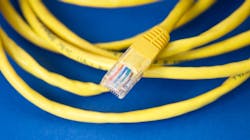Connectivity is the conduit enabling today’s manufacturers to fully capitalize on the growing array of emerging technologies. Of course, standards are crucial for connectivity to work across an array of disparate products.
The IEEE 802 standards that provide consistency for connectivity just turned 40. To learn more about how these standards apply to today’s manufacturers, IndustryWeek connected with a few members of the IEEE 802 working group: John D'Ambrosia, IEEE member and IEEE 802 executive committee member and George Zimmerman, IEEE senior member and IEEE 802 executive committee member.
D’Ambrosia: The IEEE 802 Working Group has a long history, which includes the development of technologies, such as Ethernet and Wi-Fi, that have had a huge impact on the world and our everyday lives. Today, IEEE 802 consists of 70 active standards, addressing a multitude of wired, wireless, and other bridging applications – the standards total 27,101 pages. In particular, the manufacturing sector has leveraged many of these standards in various ways – from the use of Ethernet to create an office backbone to leveraging Ethernet and Wi-Fi solutions to interconnect the computers in their office and leveraging cloud-based technologies like every other business.
The manufacturing sector has a history of leveraging various 802 technologies in a proprietary fashion for various applications related to its business, which in the recent past has moved to using specific 802 standards to enable interconnectedness.
Ethernet’s history spans nearly 50 years with the first IEEE 802.3 standard published in 1983. Today, the standard consists of nearly 5,600 pages and is constantly being added to and amended with new specifications. Today’s Ethernet family spans from 10 Mb/s to 400 Gb/s and covers a wide array of copper and optical mediums, such as copper traces connecting integrated circuits and optical modules, single and 4 pair unshielded twisted pair, twin-axial cabling, multi-mode fiber and single mode fiber.
These various Ethernet standards have become the workhorse of many different application spaces, such as data center Ethernet, automotive Ethernet, power-over-Ethernet and industrial Ethernet. Industrial automation was first for one-on-one information purposes, such as programming devices from a laptop. By the early 2000’s, the usage was extended to real-time control protocols. The emergence of economical bridges (switches), as opposed to hubs, was the enabler for real-time control applications.
Usage has grown to the point where most industrial automation devices are connected to an Ethernet-based network. Recent trends are focused on pulling additional information from devices for analytic purposes – optimizing the production process and informing maintenance decisions. It is now common to hear of the convergence of information technology and operational technology (IT/OT).IW: What role will the next generation of wired connectivity play in the factory of the future?
Zimmerman: A large portion of industrial automation devices leverage the common 4 pair BASE-T Ethernet link technologies, but there are still several proprietary non-802 solutions being utilized. But end users are requesting a more harmonized system that addresses devices at the edge. This type of system would have many benefits, including the elimination of application-level protocol conversions and finding a workforce educated in niche protocols.
To displace non-802 networks in industrial applications, certain enhancements were needed within the 802.3 suite. These enhancements included the extension of distances, improved compatibility with intrinsic safety design, and achieving a balance in the economics between the devices and their network interfaces.
Part of the emerging next generation of connectivity is the “Single Pair Ethernet” family of solutions that covers a range of speeds from multi-gigabit down to 10 Mbit/s – these solutions include reaches to 1km and power delivery over a single pair of conductors. With the Ethernet standard defining this family, watch out for the buildout of the next generation of connectivity, courtesy of Industrial Ethernet.
IW: What IEEE 802.3 standards are poised to have the largest impact on Industry 4.0?
D’Ambrosia: Advancements in wired connectivity are poised to have a significant impact on industry through the expansion of Ethernet to the factory floor – one of the things I’m most excited for is providing power to devices in areas of factories requiring intrinsic safety standards be met.
IEEE 802.3 recently standardized IEEE 802.3cg-2019 with 10BASE-T1L due to the industrial community’s need for reach and intrinsic safety. As part of a new suite of single-pair Ethernet wired transmission technologies, 10BASE-T1L and the other members of the “BASE-T1” Single Pair Ethernet (SPE) family are poised to provide connectivity and power to nodes that are fixed in location on the factory floor. While these may be the slower-speed members of the Ethernet family, they increase the data rates available in industry by orders of magnitude to meet the needs of Industry 4.0.
Industrial automation and real-time control are poised to benefit greatly from the 802.1 Time Sensitive Networking (TSN) suite of standards, which will enable today’s specialized control networks to migrate into a seamless 802-based network that’ll provide wired and wireless Ethernet capabilities throughout the factory. The impact of TSN is pervasive enough that even non-802 connectivity solutions, such as 5G technology, are adopting it.
IW: What do you see as the biggest integration challenges?
Zimmerman: Perhaps the biggest integration challenge comes from the fact that there is no single “factory of the future.” Each application has its own unique set of requirements for physical and network-level connectivity. With 802.3, though, this is not an issue, but a strength, as the standards offer mechanisms to meet these for a large variety of flexible factories.
Because of 802’s wide array of physical communications offerings, there are plenty of options for integrating them into the factories of the future. From well-known wired Ethernet to the new single-pair Ethernet standards and emerging wireless applications, the integration of physical layer 802 technologies is manageable. 802.3 offers a variety of physical connections, including wireless, wired, and optical, both with and without power, and these allow the integrator to choose based on their applications.
The requirements of a particular application at the network level are met by TSN. Because TSN encompasses a large set of standards and potential functionality, integrating the 802.1 TSN features, which are often specific to the application, is perhaps the biggest integration challenge. IEEE 802 has multiple efforts underway to specify profiles to help the integrator select and enable the right combinations of TSN functionality.
Additionally, a joint effort is underway (IEC/IEEE 60802) to specify an interoperable subset of the TSN standards for industrial automation. Even with this, individual installations will innovate to optimize efficiency and performance, there remain challenges in configuring a TSN system and in the estimation of the system performance.
When integrating 802 technologies, it is important to consider the layers above the 802 standards. While the harmonization of the communication systems in industrial automation may reach up through the Data Link layer, the upper layers in the stack are still not harmonized. This is especially true for the application layers. OLE for Process Control Unified Architecture (OPC UA), and related efforts are working towards a more standardized model for information exchange, and these may aid in the integration of TSN functions, through IEC/IEEE 60802, down to the factory floor.
How do the IEEE 802.3 standards help drive future technological innovation in manufacturing?
Zimmerman: Manufacturers are leveraging the widespread knowledge base of standardized 802 technologies to free their available talent pool to invest in the core competencies of manufacturing.
Innovation in manufacturing can then focus not on proprietary communications protocols, but on the devices essential to the tasks at hand. For example, the purpose of devices is typically to sense processes, turn motors and perform other actuation, sequence the control functions, interface with operators and collect and analyze historical information. Becoming an expert in communication is a nuisance to those who should be focused on these core competencies.
By standardizing communication and leveraging the solutions of 802 common in enterprise and commercial local area networking, industrial automation device vendors are freed to invest in technologies focused on optimizing process control, sensing and automation without having to worry about the communications interconnect.
IW: What do today's manufacturers need to know about future IEEE 802 standards?
D’Ambrosia: The DNA of IEEE 802 can be summed up as producing high quality and market relevant standards. As an 802 standard is successfully deployed, manufacturers become more aware of the inherent quality that is written into the standards. With success comes market awareness of the application space served and increased interest in continuing the success of the standard.
IEEE 802 is an open and very welcoming community that recognizes the importance of bringing in new ideas. No special membership is required to take part. Manufacturers should consider the past successes of IEEE 802 when contemplating whether to send their employees to IEEE 802 to help the industry build consensus on new ideas, application spaces and potential standards-focused efforts.
About the Author
Peter Fretty
Technology Editor
As a highly experienced journalist, Peter Fretty regularly covers advances in manufacturing, information technology, and software. He has written thousands of feature articles, cover stories, and white papers for an assortment of trade journals, business publications, and consumer magazines.


